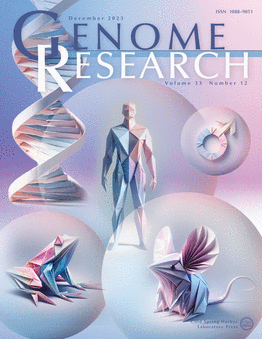直接RNA纳米孔测序揭示新生RNA成熟的遗传调控
IF 6.2
2区 生物学
Q1 BIOCHEMISTRY & MOLECULAR BIOLOGY
引用次数: 0
摘要
数量性状位点分析揭示了遗传变异在调节人类选择性剪接(AS)和选择性切割和聚腺苷酸化(APA)中的重要作用。然而,这些研究通常是用成熟的mRNA进行的,因此它们报告的是结果而不是RNA成熟的过程,因此可能忽略了变异是如何直接调节前mRNA加工的。人类基因中许多内含子被移除的顺序可以显著影响AS,而新生RNA聚腺苷化可以影响RNA的稳定性和衰变。然而,剪接顺序和poly(A)尾长是如何受遗传变异调控的还没有被研究过。在这里,我们使用直接RNA纳米孔测序来研究12种人淋巴母细胞样细胞系的等位基因特异性前mrna成熟。我们发现等位基因之间频繁的剪接顺序差异,并在17个基因中发现显著的单核苷酸多态性(SNP)-剪接顺序关联。这包括位于剪接位点或附近的snp,以及更远的内含子和外显子snp。此外,一些基因表现出等位基因特异性的多(A)尾长,其中许多基因还具有扭曲的等位基因丰度比。HLA I类转录本编码在抗原呈递中起重要作用的蛋白质,显示出最多的等位基因特异性剪接顺序,这种剪接顺序经常与等位基因特异性AS、APA或poly(A)尾长度差异共同发生。总之,我们的研究结果揭示了前mrna成熟的遗传调控的新层面,并强调了长读RNA测序在等位基因特异性分析中的作用。本文章由计算机程序翻译,如有差异,请以英文原文为准。
Genetic regulation of nascent RNA maturation revealed by direct RNA nanopore sequencing
Quantitative trait loci analyses have revealed an important role for genetic variants in regulating alternative splicing (AS) and alternative cleavage and polyadenylation (APA) in humans. Yet, these studies are generally performed with mature mRNA, so they report on the outcome rather than the processes of RNA maturation and thus may overlook how variants directly modulate pre-mRNA processing. The order in which the many introns of a human gene are removed can substantially influence AS, while nascent RNA polyadenylation can affect RNA stability and decay. However, how splicing order and poly(A) tail length are regulated by genetic variation has never been explored. Here, we used direct RNA nanopore sequencing to investigate allele-specific pre-mRNA maturation in 12 human lymphoblastoid cell lines. We find frequent splicing order differences between alleles and uncover significant single-nucleotide polymorphism (SNP)-splicing order associations in 17 genes. This includes SNPs located in or near splice sites as well as more distal intronic and exonic SNPs. Moreover, several genes showed allele-specific poly(A) tail lengths, many of which also have a skewed allelic abundance ratio. HLA class I transcripts, which encode proteins that play an essential role in antigen presentation, show the most allele-specific splicing orders, which frequently co-occur with allele-specific AS, APA, or poly(A) tail length differences. Together, our results expose new layers of genetic regulation of pre-mRNA maturation and highlight the power of long-read RNA sequencing for allele-specific analyses.
求助全文
通过发布文献求助,成功后即可免费获取论文全文。
去求助
来源期刊

Genome research
生物-生化与分子生物学
CiteScore
12.40
自引率
1.40%
发文量
140
审稿时长
6 months
期刊介绍:
Launched in 1995, Genome Research is an international, continuously published, peer-reviewed journal that focuses on research that provides novel insights into the genome biology of all organisms, including advances in genomic medicine.
Among the topics considered by the journal are genome structure and function, comparative genomics, molecular evolution, genome-scale quantitative and population genetics, proteomics, epigenomics, and systems biology. The journal also features exciting gene discoveries and reports of cutting-edge computational biology and high-throughput methodologies.
New data in these areas are published as research papers, or methods and resource reports that provide novel information on technologies or tools that will be of interest to a broad readership. Complete data sets are presented electronically on the journal''s web site where appropriate. The journal also provides Reviews, Perspectives, and Insight/Outlook articles, which present commentary on the latest advances published both here and elsewhere, placing such progress in its broader biological context.
 求助内容:
求助内容: 应助结果提醒方式:
应助结果提醒方式:


